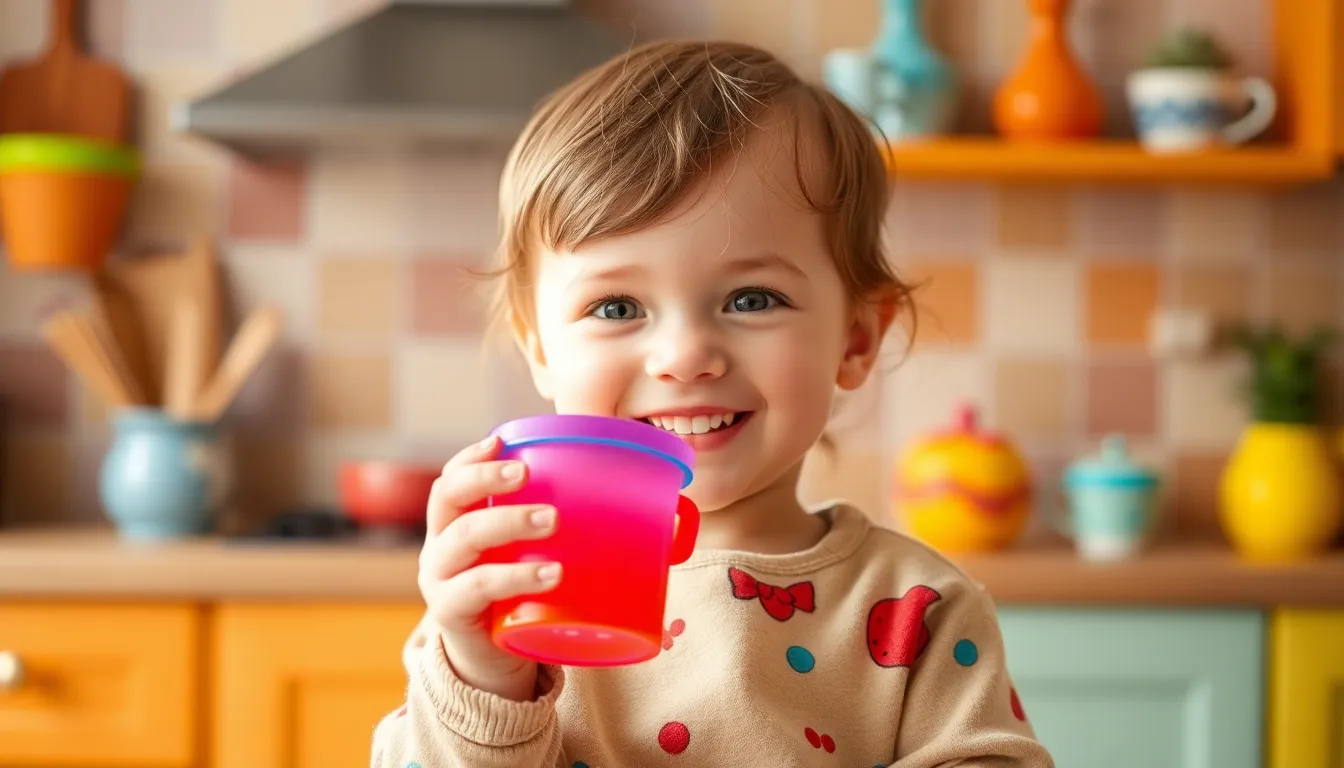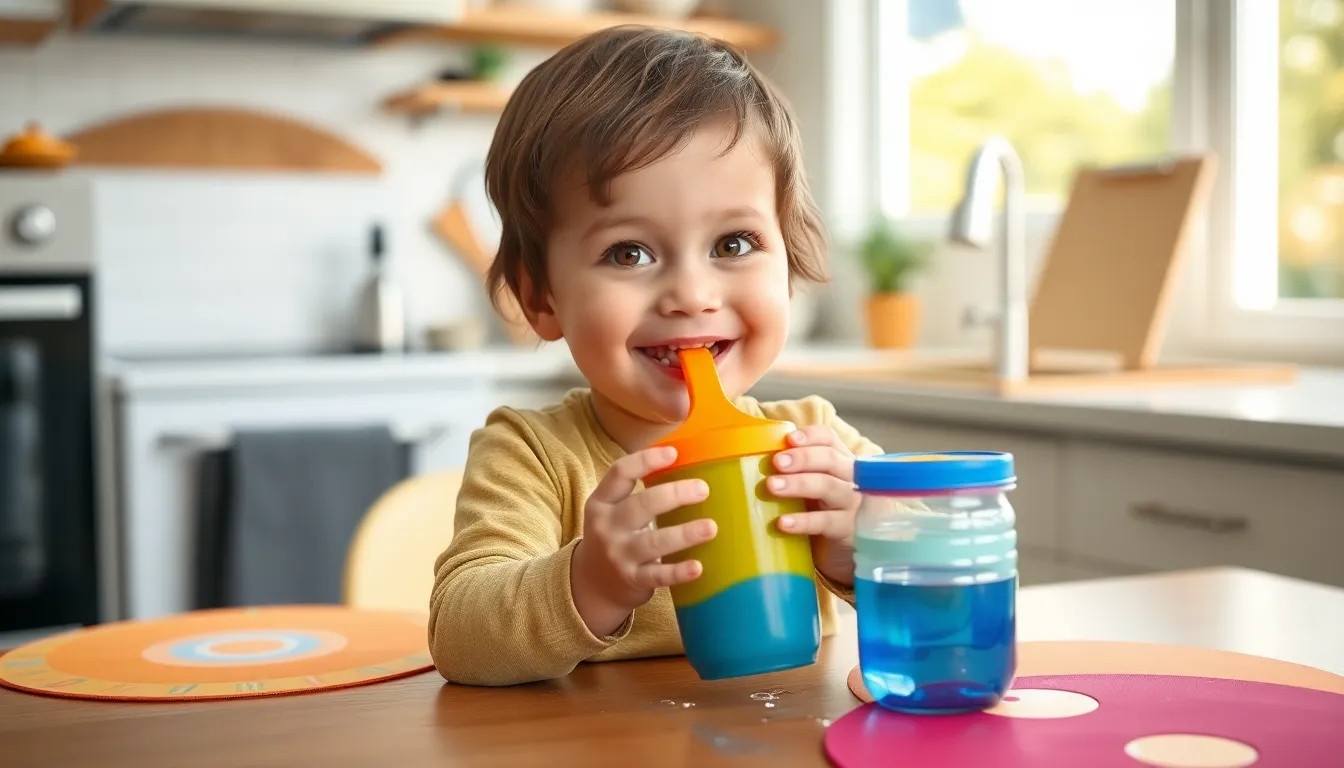When it comes to toddler milestones, mastering the art of drinking from a cup is right up there with walking and saying “no” for the first time. Parents everywhere know the struggle: one moment, the cup is a new toy, and the next, it’s a fountain of spilled juice. But fear not! Training cups are here to save the day, turning messy moments into fun-filled adventures.
Table of Contents
ToggleOverview of Training Cups for Toddlers
Training cups help toddlers transition from bottles to regular cups. These cups feature designs that cater to small hands and developing motor skills. Various types of training cups are available, including those with soft spouts, hard spouts, and open designs.
Soft spout cups usually have a flexible drinking surface. This design mimics the feel of breastfeeding or bottle feeding, making it less intimidating. Hard spout cups provide a stable option and assist toddlers in learning proper sipping skills, though spills can still occur. Open cups, often used later in the training process, encourage toddlers to practice balance and coordination.
Features important to consider include spill-proof lids, ergonomic handles, and materials. Many parents prefer BPA-free plastics or stainless steel for safety. Additionally, some cups include built-in straws to promote sipping skills while minimizing mess.
Parents may choose to introduce training cups gradually, offering them alongside regular bottle feeding. This gradual approach helps toddlers become increasingly comfortable with the new drinking method. The goal focuses on independence, fostering confidence as they learn to drink without assistance.
As toddlers experiment with different designs, they develop personal preferences. Some children might favor a specific color or character, while others prioritize functionality. Establishing a routine around cup usage can enhance the learning experience, reinforcing consistency and reducing resistance.
Training cups play a crucial role in helping toddlers master independent drinking, making the transition smoother and enjoyable for both parents and children.
Features to Consider

Selecting the right training cup involves understanding various key features. Consider the following aspects to ensure the best choice for toddlers.
Material Types
Material types play a significant role in the safety and usability of training cups. BPA-free plastic is often lightweight and colorful, making it attractive for toddlers. Stainless steel provides durability and temperature control, keeping drinks cooler longer. Glass options, while heavier, offer a natural feel and can be eco-friendly. Choosing materials that are free from harmful chemicals ensures safety during use and enhances longevity.
Spill-Proof Designs
Spill-proof designs facilitate mess-free drinking experiences. Many training cups incorporate valve systems that limit liquid flow, reducing spills while toddlers learn to sip. Some designs feature silicone seals, which help maintain leak-proof capabilities. When toddlers tip or shake their cups, these designs provide security, encouraging them to explore their drinking skills without overwhelming parents with cleanup.
Ease of Cleaning
Ease of cleaning matters significantly for parents juggling multiple tasks. Look for training cups with fewer parts that are dishwasher-safe for simple maintenance. Many options come apart easily, allowing for thorough cleaning and sanitization. Additionally, wide openings make it easier to reach the inside with a cleaning brush. These factors collectively simplify the cleaning process and keep cups hygienic for daily use.
Benefits of Using Training Cups
Training cups provide significant advantages for toddlers learning to drink independently. They not only build essential motor skills but also enhance overall confidence in daily routines.
Encouragement of Independent Drinking
Encouraging independent drinking helps toddlers gain confidence. By using training cups, they learn to control their sipping without help. Small hands can easily grip ergonomic handles, making it simpler for them to lift cups. Experimenting with various designs allows toddlers to find what feels comfortable. Building this skill fosters a sense of accomplishment as they succeed with each sip. Encouragement through this process boosts their willingness to try again after spills.
Transition from Bottle to Cup
Transitioning from bottle to cup is a crucial milestone for toddlers. Training cups facilitate this shift by mimicking familiar feeding methods. Soft spouts ease the change by resembling breastfeeding, while hard spouts promote proper sipping techniques. Offering open cups introduces balance and coordination. Gradual exposure alongside bottle feeding ensures a smooth adjustment for little ones. Involving them in this transition creates a supportive atmosphere, allowing them to develop confidence as they explore new drinking methods.
Popular Brands on the Market
Popular brands excel at providing quality training cups for toddlers. Each brand offers unique features that appeal to parents and children alike.
Brand A Overview
Brand A focuses on ergonomic designs that fit small hands comfortably. Their training cups feature spill-proof valves that prevent leaks while toddlers learn to sip. Parents appreciate the variety of colors and fun characters that attract young users. Materials used are always BPA-free, ensuring safety for little ones. Additionally, the cups offer easy-clean designs, making maintenance straightforward for busy families.
Brand B Overview
Brand B emphasizes adaptability in their training cup selection. With options ranging from soft spouts to open cups, they cater to different learning stages. Each design promotes motor skill development and encourages independence. Brand B’s emphasis on durability stands out, as materials used withstand everyday use. Parents enjoy the dishwasher-safe feature, which simplifies cleaning after messy meals. The playful designs also help make the transition from bottle to cup more enjoyable for toddlers.
Tips for Choosing the Right Training Cup
Selecting the right training cup involves considering several key factors. Prioritize spill-proof designs to minimize messes during the learning process. Ergonomic handles fit small hands comfortably, promoting independent drinking experiences.
Consider materials used in manufacturing. BPA-free plastics offer lightweight, colorful options. Stainless steel presents durability and helps maintain beverage temperatures.
Examine cup designs for versatility and adaptability. Training cups with soft spouts mimic breastfeeding, easing the transition. Hard spouts encourage proper sipping skills, while open cups foster balance and coordination.
Evaluate ease of cleaning as a crucial aspect. Dishwasher-safe components simplify maintenance for busy parents. Look for designs with minimal crevices to ensure thorough cleaning.
Assess age-appropriateness with respect to your child’s developmental stage. Choose cups designed specifically for their age range to enhance usability and engagement.
Incorporate gradual exposure to various cup designs. Experimenting with different styles fosters preferences and confidence in drinking. Establishing a routine helps toddlers adapt smoothly to new skills.
Pay attention to fun and engaging designs, too. Bright colors and playful themes attract young users, making the transition enjoyable. Brands that prioritize these features often enhance a toddler’s willingness to try new things.
By focusing on these practical aspects, parents can effectively facilitate their child’s transition from bottles to cups.
Training cups are essential tools that support toddlers in achieving independence and confidence during their drinking journey. By selecting the right cup that aligns with a child’s developmental needs and preferences, parents can make this transition smoother and more enjoyable. The variety of designs available ensures that there’s a perfect fit for every child, whether they prefer soft spouts or open cups.
As toddlers practice their sipping skills, parents can cherish the small victories that come with each successful attempt. Embracing this learning process not only minimizes spills but also fosters a sense of accomplishment in young children. With the right approach and the right training cup, parents can help their toddlers navigate this important milestone with ease.





